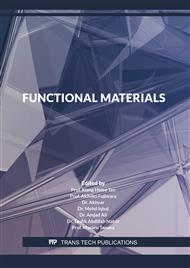[1]
Sanei SHR, Popescu D. 3D-Printed Carbon Fiber Reinforced Polymer Composites: A Systematic Review. J. Compos. Sci. 2020;4(3):98.
DOI: 10.3390/jcs4030098
Google Scholar
[2]
Yasa E, Ersoy K. A Review on the Additive Manufacturing of Fiber Reinforced Polymer Matrix Composites. Solid Freeform Fabrication Symposium;2018:1024–33.
Google Scholar
[3]
Mark GT, Benhaim D, et al. Methods for Fiber Reinforced AM(US 9,694,544 B2); (2017).
Google Scholar
[4]
Azarov AV, Golubev MV, Antonov FK, Khaziev AR. Print Head for Additive Manufacturing of Articles - European Patent Office - EP 3611007 A1(EP 3611007A1); (2020).
Google Scholar
[5]
Mason H, Gardiner G. 3D printing with continuous fiber: A landscape. [July 29, 2021].
Google Scholar
[6]
Dickson AN, Abourayana HM, Dowling DP. 3D Printing of Fibre-Reinforced Thermoplastic Composites Using Fused Filament Fabrication-A Review. Polymers 2020;12(10).
DOI: 10.3390/polym12102188
Google Scholar
[7]
Azarov AV, Antonov FK, Golubev MV, Khaziev AR. Production of Articles made of Composite Materials by 3D-Printing Method(US 2020/0230878 A1); (2020).
Google Scholar
[8]
Mark GT. Methods for Fiber Reinforced AM(US 2019/0168451 A1); (2019).
Google Scholar
[9]
Matsuzaki R, Ueda M, Namiki M, Jeong T-K, Asahara H, Horiguchi K et al. Three-dimensional printing of continuous-fiber composites by in-nozzle impregnation. Sci Rep 2016;6:23058.
DOI: 10.1038/srep23058
Google Scholar
[10]
Tian X, Liu T, Yang C, Wang Q, Li D. Interface and performance of 3D printed continuous carbon fiber reinforced PLA composites. Composites Part A 2016;88:198–205.
DOI: 10.1016/j.compositesa.2016.05.032
Google Scholar
[11]
Dickson AN, Barry JN, McDonnell KA, Dowling DP. Fabrication of continuous carbon, glass and Kevlar fibre reinforced polymer composites using AM. Addit. Manuf. 2017;16:146–52.
DOI: 10.1016/j.addma.2017.06.004
Google Scholar
[12]
Popescu D, Zapciu A, Amza C, Baciu F, Marinescu R. FDM process parameters influence over the mechanical properties of polymer specimens. Polymer Testing 2018;69(7):157–66.
DOI: 10.1016/j.polymertesting.2018.05.020
Google Scholar
[13]
Dey A, Yodo N. A Systematic Survey of FDM Process Parameter Optimization and Their Influence on Part Characteristics. JMMP 2019;3(3):64.
DOI: 10.3390/jmmp3030064
Google Scholar
[14]
Solomon IJ, Sevvel P, Gunasekaran J. A review on the various processing parameters in FDM. Materials Today: Proceedings 2021;37(1):509–14.
DOI: 10.1016/j.matpr.2020.05.484
Google Scholar
[15]
Jasiuk I, Abueidda DW, Kozuch C, Pang S, Su FY, McKittrick J. An Overview on Additive Manufacturing of Polymers. JOM 2018;70(3):275–83.
DOI: 10.1007/s11837-017-2730-y
Google Scholar
[16]
SGL Carbon. Product Data Sheet SIGRAFIL® C SB70-3.3/240-R100.
Google Scholar
[17]
LehmannVoss. LUVOCOM 3F PAHT 9825 NT. [September 22, 2021]; Available from: https://www.luvocom.de/fileadmin/user_upload/luvocom/Downloads/LUVOCOM_3F_PAHT_9825_NT.pdf.
Google Scholar
[18]
Hexcel Corporation. HexFlow® RTM6: 180 °C Mono-component epoxy system for Resin Transfer Moulding and Infusion technologies. [September 22, 2021]; Available from: https://www.hexcel.com/user_area/content_media/raw/RTM6_DataSheetPDF.pdf.
Google Scholar
[19]
Gorton BS. Interaction of nylon polymers with epoxy resins in adhesive blends. Journal of Applied Polymer Science 1964(8):1287–95.
DOI: 10.1002/app.1964.070080319
Google Scholar
[20]
Choe Y, Kim M, Kim W. In Situ Detection of the Onset of Phase Separation and Gelation in Epoxy/Anhydride/Thermoplastic Blends. Macromolecular Research 2003;11(4):267–72.
DOI: 10.1007/bf03218363
Google Scholar
[21]
Heflin D, et al. Impact Behavior of Epoxy-Polyamide Hybrid Laminates. SAMPE Europe (2020).
Google Scholar
[22]
Menczel JD, Prime RB. Thermal Analysis of Polymers: John Wiley & Sons, Inc; (2009).
Google Scholar



